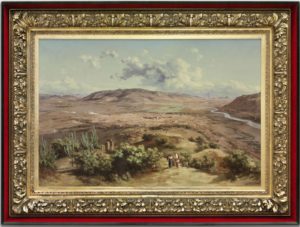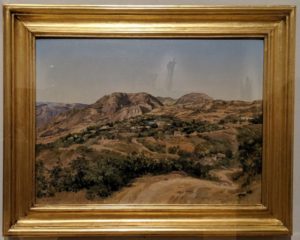An exhibit at the National Museum of Mexican Art this summer features the early artistic involvement and influence of Mexican immigrants in Chicago, beginning with the World’s Columbian Exposition in 1893. Arte Diseño Xicágo: Mexican Inspiration from the World’s Columbian Exposition to the Civil Rights Era runs through August 19, 2018, in the Main Gallery.

Arte Diseño Xicágo Mexican Inspiration from the World’s Columbian Exposition to the Civil Rights Era at the National Museum of Mexican Art in Chicago.
The first section of the exhibit focuses on the 1893 World’s Fair and painter José María Velasco (1840-1912). One of Mexico’s foremost artists in the late 19th century, Velasco arrived in Chicago in April of 1893 to serve as a Commissioner for Fine Arts for the Mexican delegation to the Fair.
Among the 80 canvases by Mexican artists displayed in the Palace of Fine Arts, Velasco exhibited seventeen oil paintings, including these (with titles listed in the Revised Catalogue, Department of Fine Arts):
• Valley of Oaxaca
• The City of Mexico, from the Hill of Santa Ysabel
• View of Chimalhistac
• The Volcano of Orizaba, Viewed from Cordoba
• View of Chimalpan
• The Valley of Mexico
• Glen of Metlac
• A Mexican Landscape
• Pitahaya
• The Herd
• The Tree of the “Noche Triste”
• The City of Mexico, from the Hill of Atzacoalco
• Volcanos Txtaccihuatl and Popocatepetl
• The Volcano of Orizaba, viewed from Cordoba (presumably a second view)
• The Town of Guelatao
• Penon de los Banos (Natural Hot Springs)
• The Valley of Mexico, from the Hill of Santa Ysabel

Valley of Oaxaca (1888), now in the collection of the Philadelphia Museum of Art.

Valley of Mexico from the Santa Isabel Mountain Range (1875), now in the collection of the Museo Nacional de Arte, Mexico City.

Cocina rústica en el Peñon de los Baños (1878), now in the collection of the Museo Nacional de Arte, Mexico City.
For the Arte Diseño Xicágo exhibit, the Museo Nacional de Arte in Mexico City loaned the painting Guelatao, Estado de Oaxaca (1887); presumably this is the same work listed in the 1893 World’s Fair catalogs under the title The Town of Guelatao.

Guelatao, Estado de Oaxaca (1887) from the Museo Nacional de Arte in Mexico City on display at the National Museum of Mexican Art in Chicago.
Another painting returning to Chicago after 125 years is José Maria Jara’s El Velorio (The Wake). The exhibit describes this 1889 oil painting of a funeral custom as depicting “common Mexican people with dignity and respect.” Jara studied under Velasco, who selected this work for inclusion in the Mexican exhibit in 1893. Jara also showed his painting Episode of the Foundation of the City of Mexico at the Fair.

José Maria Jara’s El Velorio (The Wake) on display at the National Museum of Mexican Art in Chicago.
Despite not having their own national pavilion at the Columbian Exposition, Mexico exhibited in the nearly all of the great exhibit halls throughout the fairgrounds and won more than a thousand awards. At a time when the population of Mexicans living in Chicago was still quite small, these displays served as an important cultural and economic exchange.

A description of the World’s Columbian Exposition at the National Museum of Mexican Art in Chicago.
An interesting example of a less formal exchange between Mexico and the U.S. is highlighted in the National Museum of Mexican Art exhibit through a quote on the gallery wall. The passage comes from a letter Velasco wrote home on May 14, 1893, describing his encountering a man in downtown Chicago selling “Mexican tamales.” Food historians think this may be the first known reference to tamales in the United States.

Quote from José María Velasco in the gallery of the National Museum of Mexican Art in Chicago
In another epistolary passage in the exhibit, Velasco shares this observation about the U.S. in the “Gilded Age” of the 1890s:
“… Americans are only very interested in tomorrow and that their children inherit a stable house. I just don’t understand why they are so interested in money if they are not going to enjoy it. The American character is very different from ours; we devote our life to family and they devote theirs to business.”
SOURCES
Jirasek, Rita Arias; Tortolero; Carlos Mexican Chicago (Images of America series). Arcadia Publishing, 2001.
Revised Catalogue, Department of Fine Arts. W. B. Conkey, 1893.
World’s Columbian Exposition, 1893 Official Catalogue Part X. Department K. Fine Arts. W. B. Conkey, 1893.






Leave A Comment